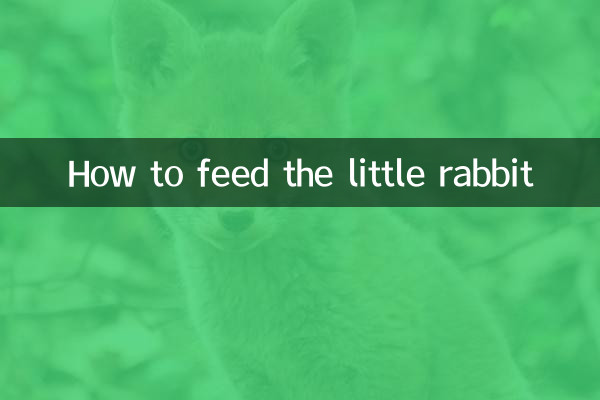How to feed the little rabbit
Recently, among the popular topics about pet feeding, the feeding methods of little rabbits have attracted much attention. Many novices have many questions about how to feed their little rabbits scientifically. This article will analyze the feeding points of little rabbits in detail from the aspects of diet, environment, health management, etc., and attach structured data for reference.
1. Diet management of the little rabbit

The diet of the little bastard is the key to his healthy growth. Here are some things to pay attention to when feeding a little rabbit:
| Food Type | Feeding frequency | Things to note |
|---|---|---|
| Breast milk or milk replacement | 4-6 times a day | Bunny aged 0-3 weeks need to rely on breast milk or special milk replacement |
| Alfalfa | Unlimited supply | It can be introduced gradually after 3 weeks of age, rich in protein and calcium |
| Baby rabbit food | 2-3 times a day | Choose special rabbit food with high fiber and low starch |
| Fresh vegetables | Introduce a small amount | After 4 weeks of age, you can try carrot leaves, dandelions, etc. |
2. Little rabbit's living environment
The little babies have high requirements for the environment, and the following are some key points:
| Environmental factors | Require | illustrate |
|---|---|---|
| temperature | 20-25℃ | Young rabbits are sensitive to temperature and need to avoid excessive temperature difference |
| Cage | Flat bottom | Avoid barbed wire bottoms to prevent foot dermatitis |
| Cushion material | Strong water absorption | It is recommended to use wood chips or special bedding and replace them regularly |
| Event space | 1-2 hours a day | A safe area for activity is required |
3. Health management of the little rabbit
The health status of the little bastard needs to be closely watched. Here are the precautions for common health problems:
| Health issues | symptom | Preventive measures |
|---|---|---|
| diarrhea | Slim and soft feces | Avoid sudden changes in food and maintain hygiene in food |
| Coccidiosis | Weakness, loss of appetite | Regularly deworm and keep the environment dry |
| Respiratory Diseases | Sneeze, runny nose | Avoid moisture and poor ventilation |
4. Behavior training of little rabbits
Cultivating good behavioral habits from an early age is very important for the growth of the little babies:
| Training Programs | method | Best time |
|---|---|---|
| Fixed-point excretion | Place the toilet in a fixed location | Beginning at 4 weeks |
| Social training | Moderate interaction every day | Starting at 2-3 weeks |
| Adapt to touch | Gently caress the whole body | Beginning at 3 weeks |
5. Common misunderstandings about feeding little rabbits
Based on recent hot online discussions, the following common feeding misunderstandings have been sorted out:
| Misconception | The correct way to do it | reason |
|---|---|---|
| Overload fresh vegetables | A small number of gradually introduced | Young rabbits have not developed their digestive system completely |
| Use cat litter as padding | Use special padding | Cat litter may be taken by accident and cause danger |
| Feeding human snacks | Only feed rabbits for food | Sugar and salt are harmful to rabbits |
Through the above structured data and detailed instructions, I hope it can help you feed your little rabbit scientifically. Remember that each little bastard is a unique individual, and you should closely observe its reaction during feeding and consult a professional veterinarian if necessary. I wish you a happy time with the little rabbit!

check the details

check the details